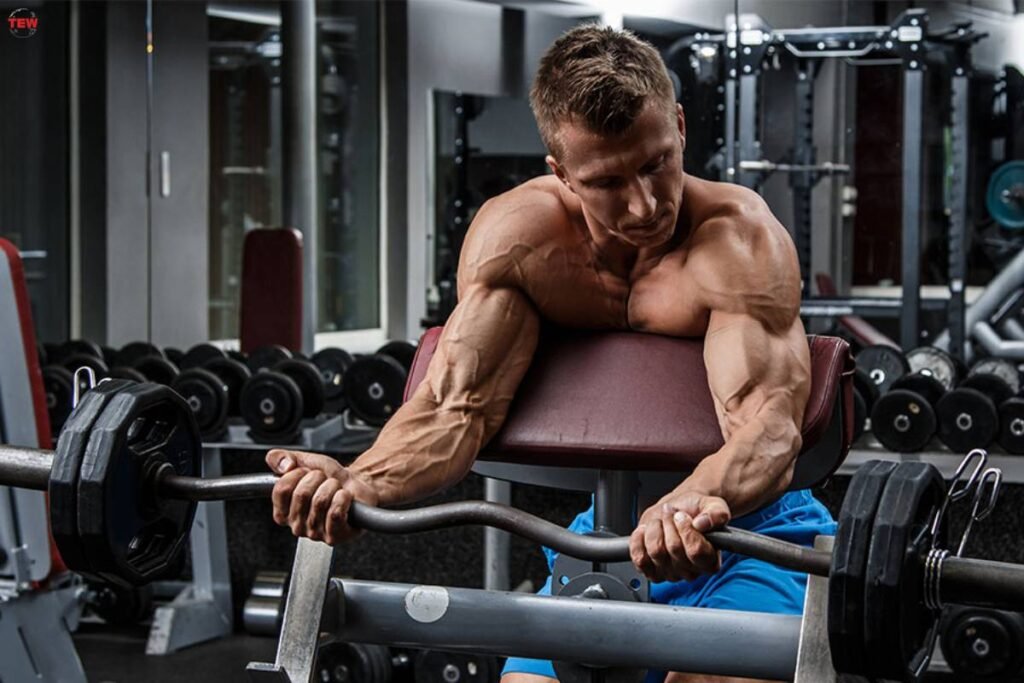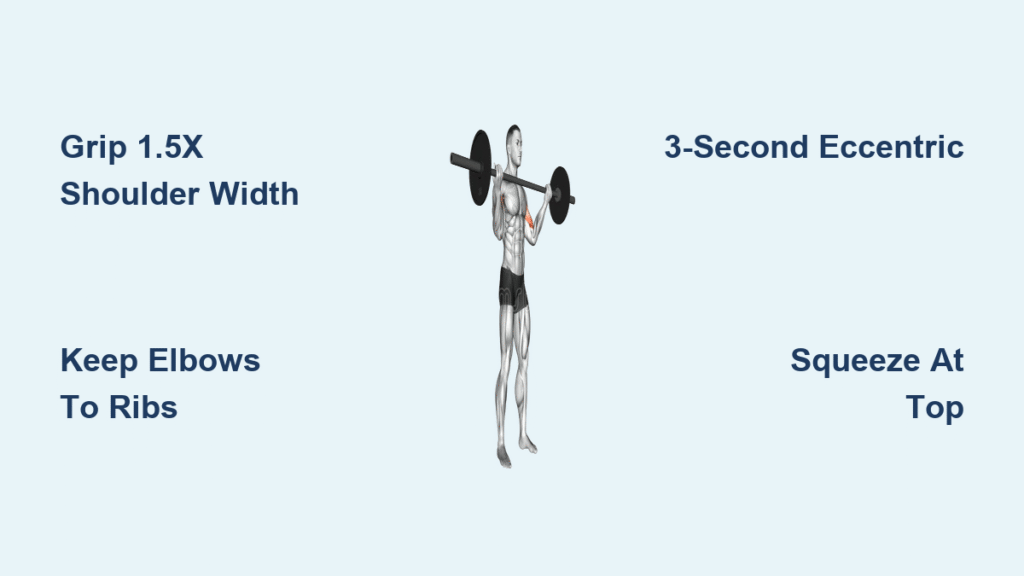Your biceps might be strong, but do they create that impressive width that makes sleeves strain? The standard barbell curl builds peak height, but the wide grip barbell curl uniquely targets the inner biceps head responsible for arm thickness when viewed head-on. When you grip the bar significantly wider than shoulder-width, you shift mechanical tension to build the biceps width that transforms “strong arms” into “massive arms.” This guide reveals exactly how to leverage this variation for maximum 3D arm development while avoiding common pitfalls that sabotage results.
Unlike traditional curls that emphasize the outer biceps peak, the wide grip barbell curl creates horizontal abduction at your shoulders. This mechanical disadvantage forces the short head (the inner portion of your biceps) to bear most of the workload. Since this muscle section directly contributes to front-view arm thickness, mastering this variation delivers the sleeve-filling width lifters chase. You’ll learn precise form cues, programming strategies, and equipment hacks to make every set count toward wider, more imposing arms.
Why Wide Grip Curls Target Biceps Width Differently

Short Head Activation Mechanics Explained
When you widen your grip beyond shoulder-width during barbell curls, your upper arms move into horizontal abduction. This position mechanically disadvantages the long head of your biceps while placing the short head under maximum tension throughout the movement. Think of it like shifting gears in a car—the wide grip changes the leverage ratio to prioritize inner biceps development. This head creates the “thickness” that makes arms look powerful from the front, directly contributing to that coveted 3D appearance.
Secondary Muscles That Make or Break Your Form
Your biceps aren’t working alone during wide grip barbell curls. The brachialis deep beneath your biceps adds overall arm mass, while the brachioradialis assists during the bottom portion of the movement. Crucially, your upper back muscles—especially rhomboids and mid-traps—must actively maintain scapular retraction to prevent shoulder rounding. If these stabilizers fatigue, your elbows flare outward, transferring work to your anterior delts and reducing biceps tension. A tight core is equally vital; without it, your torso swings to cheat the weight up, straining your lower back instead of building arms.
Execute Wide Grip Barbell Curls with Precision
Optimal Setup for Maximum Muscle Recruitment
Stand with feet shoulder-width apart and knees slightly bent. Grip the bar 1.5 to 1.75 times your shoulder width—typically with hands just outside your outer thigh line when the bar rests at mid-thigh. Your wrists must stay neutral (not bent backward) with knuckles facing forward. Before lifting, pin your elbows to your sides and retract your shoulder blades as if squeezing a pencil between them. This setup prevents shoulder impingement and ensures tension stays on your biceps.
Step-by-Step Curl Execution Sequence
- Initiate the lift by contracting your biceps only—don’t roll your shoulders forward.
- Curl the bar in a slight arc toward your lower chest, keeping elbows stationary.
- Squeeze hard at the top for 1-2 seconds with wrists neutral to maximize short head contraction.
- Lower slowly for 3-4 seconds, stopping just before elbow lockout to maintain constant tension.
This controlled eccentric phase creates micro-tears in the short head fibers where growth happens. Rushing the descent shifts work to momentum rather than muscle.
Breathing and Tempo Protocol
Exhale forcefully as you lift the bar through the toughest part of the movement (mid-range), then inhale during the controlled lowering phase. For hypertrophy, use a 2-0-4-1 tempo: 2 seconds up, no pause at top, 4 seconds down, 1-second stretch at bottom. This tempo maximizes time-under-tension for the short head while protecting your elbows from valgus stress caused by wide grips.
Fix These Wide Grip Curl Mistakes Immediately

Stop Elbow Flare to Isolate Biceps
When your elbows drift more than 30 degrees away from your ribs, your anterior deltoids take over. This mistake is the #1 reason lifters fail to build width with wide grip barbell curls. Fix it by taping your elbows to a wall during sets or placing a folded towel under each armpit. Start with 50% of your usual weight until you can maintain “elbows to ribs” positioning through all reps. You’ll feel an intense burn in your inner biceps within two sets.
Eliminate Torso Swing Without Sacrificing Weight
Using body English to lift heavier weights transfers dangerous stress to your lumbar spine. If you can’t complete reps without swinging, you’re using too much weight. Sit on an incline bench set to 75 degrees or perform curls standing with your back against a wall. These positions eliminate momentum while allowing full biceps contraction. You’ll likely drop 30-40% of your standing weight initially, but the increased muscle damage will yield better growth.
Correct Grip Width for Joint Safety
Gripping wider than 200% of shoulder width creates excessive shoulder torque and reduces biceps tension. Measure your bi-acromial width (distance between shoulder bones), then multiply by 1.75 to find your ideal grip. For most lifters, this places hands 6-8 inches outside shoulder width. If your wrists bend backward or shoulders ache at the top, narrow your grip by 1-2 inches immediately.
Effective Wide Grip Curl Variations for Growth

Best Equipment-Based Modifications
- EZ-bar version: Reduces wrist strain by 40% while maintaining short head emphasis (ideal for lifters with tendonitis)
- Seated preacher variation: Fixes upper arms on a 45-degree pad for extreme stretch at the bottom position
- Cable machine setup: Use a straight bar attachment with wide grip for constant tension through full ROM
Advanced Techniques for Stubborn Growth
Implement 21s protocol once weekly: 7 partial reps from bottom-to-mid position, 7 from mid-to-top, then 7 full-range reps without rest. For time-crunched lifters, grip micro-progression works wonders—widen your hands by 1cm every two weeks to continually challenge the short head. Always prioritize strict form over weight; the wide grip barbell curl builds width through tension, not momentum.
Program Wide Grip Curls for Explosive Growth
Optimal Rep Schemes and Placement
Perform wide grip barbell curls first on arm day when neural drive is highest. Use these proven protocols:
– Width-focused: 4 sets × 10-12 reps with 3-second eccentric (65-75% 1RM)
– Strength-width hybrid: 5 sets × 6-8 reps with explosive concentric (75-85% 1RM)
– Finisher: 2 sets × 20 reps with 40% 1RM and 30-second rest
Never pair with other wide-grip movements—this overloads the short head without adequate recovery. Instead, follow with close-grip curls for long head development and hammer curls for brachialis thickness.
Progressive Overload Without Injury
Add weight only when you hit the top of your rep range with perfect form. A safer progression method: widen your grip by 0.5 inches after two consecutive successful sessions. This subtle change increases mechanical tension on the short head without joint stress. Every fourth week, reduce weight by 20% and focus on 5-second eccentrics to flush metabolic waste and prepare for the next loading phase.
Prevent Injuries with Smart Safety Protocols
Essential Pre-Workout Routine
Spend 5 minutes preparing specifically for wide grip barbell curls:
1. Foam roll lats and triceps (45 seconds each) to improve shoulder positioning
2. Band pull-aparts (2×15 reps) to activate scapular retractors
3. Wrist circles (30 seconds forward/backward) to lubricate joints
Skipping this routine increases elbow valgus stress by 25% during wide grip work.
Troubleshooting Common Discomfort
- Wrist pain: Switch to EZ-bar immediately and add reverse wrist curls twice weekly
- Elbow ache: Reduce volume by 50% and incorporate slow eccentric reverse curls
- Shoulder pinching: Narrow grip slightly and perform scapular pull-ups before sets
Persistent pain means stopping—not pushing through. The wide grip barbell curl shouldn’t hurt when performed correctly.
Wide Grip vs Close Grip: Strategic Application
| Factor | Wide Grip Barbell Curl | Close Grip Curl |
|---|---|---|
| Primary target | Short head (inner biceps) | Long head (outer peak) |
| Visual outcome | Arm width & front thickness | Biceps peak height |
| Ideal rep range | 8-15 reps | 6-12 reps |
| Joint stress | Higher elbow valgus | Higher wrist torque |
| Best used for | Building sleeve-filling width | Creating “21-inch arms” illusion |
This isn’t an either/or choice—program both variations. Use wide grip barbell curls early in your workout for width development, then close-grip movements for peak height. Never perform them back-to-back; allow 48 hours between similar movement patterns.
Selecting the Right Equipment for Results

Barbell Selection Guide
Choose an Olympic barbell with 28-29mm shaft diameter for maximum loadability during heavy sets. If wrist pain occurs, switch to an EZ-curl bar with 25mm cambered shaft—it reduces radial deviation by 30% while maintaining the wide-grip stimulus. Fixed-weight straight bars (like Body-Solid models) provide balanced weight distribution that improves mind-muscle connection during high-rep sets.
Maintenance for Longevity
Brush chalk from barbell knurling weekly with a nylon brush to preserve grip texture. Every three months, apply 3-in-1 oil to bar sleeves for smooth rotation during explosive concentrics. Inspect fixed barbells for cracked rubber cradles monthly—damaged cradles cause uneven weight distribution that sabotages form.
Advanced Programming for Stubborn Growth
Periodization Strategy for Width
Cycle through these phases every 4 weeks:
– Weeks 1-4: 3×10-12 reps @ 70% 1RM with 3-second eccentrics
– Weeks 5-8: 4×8-10 reps @ 75% 1RM with 1-second pauses at mid-range
– Weeks 9-12: 5×6-8 reps @ 80% 1RM with explosive concentrics
This builds structural strength before metabolic stress for sustainable width gains.
Sample Arm Day Integration
- Wide grip barbell curl: 4×10-12 (focus: short head width)
- Close grip EZ-bar curl: 3×12-15 (focus: long head peak)
- Incline dumbbell curl: 3×15 (focus: stretch-mediated hypertrophy)
- Hammer curl: 2×20 (focus: brachialis thickness)
Perform this sequence once weekly for 12 weeks. You’ll notice measurable width increases in your biceps’ inner sweep within 30 days.
Key Takeaways for Wider Biceps
The wide grip barbell curl uniquely builds the inner biceps width that transforms arms from strong to imposing. Start with 4 sets of 10-12 reps using a grip 1.5-1.75× shoulder width, prioritizing 3-second eccentrics over heavy weight. Pair it with close-grip variations for complete development, and never sacrifice form for ego lifting. Within 8 weeks of consistent programming, your shirtsleeves will feel noticeably tighter across the biceps—proof that targeted width training delivers real results.




